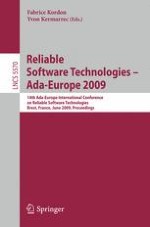This book constitutes the proceedings of the 14th Ada-Europe International Conference on Reliable Software Technologies, Ada-Europe 2009, held in Brest, France, on June 8-12, 2009. The 19 papers presented were carefully reviewed and selected from numerous submissions. Topics of interest to the conference are methods and techniques for software development and maintenance; software architecture; enabling technology; software quality; theory and practice of high-integrity systems; embedded systems; mainstream and emerging applications; ada language and technology; ada and education.
